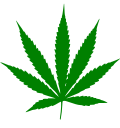Bhang/ja: Difference between revisions
Created page with "thumb|1893年のインド麻薬委員会報告書からのバングーを飲む人々の写真 thumb|バングー thumb|right|[[:en:Punjab, India|インドのパンジャーブ州の村でのバングー製造工程]] {{Cannabis sidebar}} '''バングー'''(:en:International Alphabet of Sanskrit..." |
No edit summary |
||
| (19 intermediate revisions by the same user not shown) | |||
| Line 6: | Line 6: | ||
'''バングー'''([[:en:International Alphabet of Sanskrit Transliteration|IAST]]: ''Bhāṅg'')は、インドを発祥とする[[Cannabis (drug)/ja|アサ]]の葉から作られる[[cannabis edible/ja|食用の調合薬]]である。''[[Cannabis sativa/ja|大麻]]'' はバングー調製に用いられる植物の学名である。バングーはアサの調製薬の中で最も害の少ない形態であると信じられており、古代インドでは薬用にも用いられていた。これは、バングーにはアサの頂端の花序やアサの植物が生成する樹脂が含まれていないためである。バングーは早くも[[:en:ancient India|古代インド]]の紀元前1000年には飲食物として使用されていた。バングーは伝統的に春の祭りである[[:en:Maha Shivaratri|マハ・シヴァラートリー]]と[[:en:Holi|ホーリー]]の期間に配布される。バングは主に、アサを注入したインドの飲み物であるバングー[[lassi/ja|ラッシー]]とバングー[[thandai/ja|タンダイ]]を販売するバングー店で利用される。 | '''バングー'''([[:en:International Alphabet of Sanskrit Transliteration|IAST]]: ''Bhāṅg'')は、インドを発祥とする[[Cannabis (drug)/ja|アサ]]の葉から作られる[[cannabis edible/ja|食用の調合薬]]である。''[[Cannabis sativa/ja|大麻]]'' はバングー調製に用いられる植物の学名である。バングーはアサの調製薬の中で最も害の少ない形態であると信じられており、古代インドでは薬用にも用いられていた。これは、バングーにはアサの頂端の花序やアサの植物が生成する樹脂が含まれていないためである。バングーは早くも[[:en:ancient India|古代インド]]の紀元前1000年には飲食物として使用されていた。バングーは伝統的に春の祭りである[[:en:Maha Shivaratri|マハ・シヴァラートリー]]と[[:en:Holi|ホーリー]]の期間に配布される。バングは主に、アサを注入したインドの飲み物であるバングー[[lassi/ja|ラッシー]]とバングー[[thandai/ja|タンダイ]]を販売するバングー店で利用される。 | ||
==西洋のドキュメント== | |||
== | [[Wikipedia:Garcia de Orta|Garcia de Orta]]は、[[:en:History of the Jews in Portugal|ポルトガル系ユダヤ人]]の医師であり、[[:en:Goa|ゴア]]を拠点として活動していた。彼は1563年に著した''[[Wikipedia:Colóquios dos simples e drogas da India|Colóquios dos simples e drogas da India]]''において、''bangue''について広範に記述し、[[:en:Bahadur Shah of Gujarat|グジャラートのバハードゥル・シャー]]や多くのポルトガル人による娯楽的使用についても述べている。彼は、''bangue''を生み出すインドの植物が、ヨーロッパの麻植物(''alcanave'')と同一であるという説を明確に否定した。 | ||
[[Garcia de Orta]] | |||
1596年、[[:en:Netherlands|オランダ]]人の[[Wikipedia:Jan Huyghen van Linschoten|Jan Huyghen van Linschoten]]は、自身の東方への旅を記録した著作において「Bangue」について3ページにわたって記述した。彼はまた、エジプトの[[hashish/ja|ハシーシュ]]、トルコの[[boza/ja|ボザ]]、トルコの[[bernavi/ja|ベルナヴィ]]、アラビアの[[bursj/ja|ブルシュ]]といった消費形態にも言及している。これらの記録があるにもかかわらず、現代の歴史家[[Wikipedia:Richard Davenport-Hines|Richard Davenport-Hines]]は、17世紀末から18世紀初頭のイギリス人冒険家[[Wikipedia:Thomas Bowrey|Thomas Bowrey]]を、バングーの使用を記録した最初の西洋人として挙げている。 | |||
==準備== | |||
= | [[File:Bhang ki Patti ka Peda.JPG|thumb|バングの葉で作られた[[Peda/ja|ペーダ]]]] | ||
[[File:Bhang ki Patti ka Peda.JPG|thumb|[[Peda]] | [[mortar and pestle/ja|乳鉢と乳棒]]を用いて、カンナビスの葉をペースト状にすり潰し、食品に加えることができる。飲料として使用する場合は、ミルクと混ぜて濾し、[[Desmostachya bipinnata/ja|クシャ草]]、砂糖、果物、さまざまな香辛料で風味づけされることが多い。[[Mathura/ja|マトゥラー]]では、バング入り''[[thandai/ja|タンダーイ]]''やバング入り[[lassi/ja|ラッシー]]の形で見られる。バングはまた、[[ghee/ja|ギー]]と砂糖と混ぜて紫色の[[halva/ja|ハルワー]]を作ったり、ヒンディー語で「錠剤」や「丸薬」を意味する''goli''という、胡椒風味で歯ごたえのある小さな団子状に加工されたりもする。別の形態としては、''バング[[chutney/ja|チャトニ]]''または''バンギーラ・キ・チャトニー''と呼ばれるもので、[[:en:Uttarakhand|ウッタラーカンド]]の[[Kumaoni cuisine/ja|クマオン料理]]で提供される。この料理は、カンナビスまたはバングの種子をミント、トマト、さまざまな香辛料とともにすり潰して作られる。 | ||
==文化== | |||
[[File:Bhang eaters before two huts (6124556163).jpg|thumb|left|260px|インド出身のバンイーター、1790年頃]] | |||
[[File:Bhang eaters before two huts (6124556163).jpg|thumb|left|260px| | |||
バングーは、インド亜大陸における古代の[[:en:Hindu|ヒンドゥー教]]の伝統および習慣の一部である。インドの農村部の一部では、カンナビス植物にさまざまな[[medical cannabis/ja|医療的]]効能があると信じられている。適量を摂取すれば、バングーは[[fever/ja|発熱]]、[[dysentery/ja|赤痢]]、[[sunstroke/ja|日射病]]を治癒し、[[phlegm/ja|痰]]を取り除き、[[digestion/ja|消化]]を助け、[[appetite/ja|食欲]]を増進させ、[[speech defect/ja|言語障害]]や[[lisping/ja|舌足らず]]を改善し、身体を覚醒状態にする効果があるとされている。 | |||
[[Bhang lassi/ja|バングー・ラッシー]]は、緑色の花穂を粉末にし、カード(凝乳)とホエー(乳清)とともに村のブレンダー(手動混合器)で撹拌してバターが浮かび上がるまで混ぜたものである。風味が良く爽やかな飲み物とされている。バングーはインドの多くの地域で合法であり、主に[[:en:Holi|ホーリー祭]]の時期に販売される。バングー入りの[[pakoras/ja|パコラ]]が食べられることもある。[[:en:Uttar Pradesh|ウッタル・プラデーシュ州]]には、許可を受けたバングー販売店が存在し、インド各地でバングー製品やバングー・ラッシーを購入することができる。[[:en:Bihar|ビハール州]]や[[:en:West Bengal|西ベンガル州]]のような州では、バングーの生産も認められている。[[:en:Rajasthan|ラージャスターン州]]のような州ではバングーの生産は認められていないが、生産が合法な州からの調達および販売は認められている。 | |||
[[Bhang lassi]] | |||
ホーリー祭の期間中にバングー・ラッシーを摂取する習慣は、特に北インドで一般的であり、この地域ではホーリーが他の地域とは異なる熱狂的な雰囲気で祝われる。バングーは[[:en:Mathura|マトゥラー]]で大量に消費されており、同地はヒンドゥー教徒にとって宗教的に重要な古代都市である。ここでは、[[:en:Shiva|シヴァ]]の信奉者によってこの習慣が導入され、以後定着したとされている。人々は[[:en:Sanskrit|サンスクリット語]]の詠唱と祈祷の朗唱でバングの調製を始める。マトゥラーでは、食欲を高めるためにバングーを摂取する者もいれば、ストレスを和らげるために摂取する者もいる。しかし、バングー消費の中心地は[[:en:Varanasi|ヴァーラーナシー]]であり、同地では有名なガートでバングーが調製される。 | |||
バングーは、単に大麻を水とともにすり潰しただけの''バングー・ゴリ''としても販売されている。これとは別に、甘味を加えたバングー・ゴリも広く流通しており、これらは薬物とは見なされず、伝統的な睡眠補助剤や食欲増進剤とされている。バングー・ゴリは摂取から約2時間後に代謝効果を示し、使用者を夢のような瞑想状態へと導く。バングーはまた、多くの[[Ayurvedic/ja|アーユルヴェーダ]]薬剤にも含まれている。バングー粉末はアーユルヴェーダ薬局において合法的に入手可能である。 | |||
==合法== | |||
== | [[File:Bhang shop in Jaisalmer, Rajasthan, India on November 15, 2008.jpg|thumb|right|[[:en:Jaisalmer|ジャイサルメール]]([[:en:Rajasthan, India|インド・ラージャスターン州]])にあるバングー販売店]] | ||
[[File:Bhang shop in Jaisalmer, Rajasthan, India on November 15, 2008.jpg|thumb|right| | 1961年の[[:en:Single Convention on Narcotic Drugs|麻薬に関する単一条約]]は、大麻(またはマリファナ)を他の薬物とともに初めて国際条約に含め、医療および研究目的を除き、その生産および供給を全面的に禁止した。しかしながら、同条約における「大麻」の定義には大麻植物の葉は含まれておらず、そのためインドにおけるバングー文化の合法性は維持されている。 | ||
それにもかかわらず、バングーがインドの文化および宗教的慣習において重要な役割を果たしていることから、インド全土での大麻全面禁止は成功しないと考えられている。[[:en:Holi|ホーリー]]や[[:en:Maha Shivaratri|マハー・シヴァラートリー]]といった重要な祭りでは、さまざまな地域の祭礼において人々がバングーを摂取するのが伝統である。大麻の栽培は政府により規制されている。 | |||
=== インド === | |||
=== | [[:en:Narcotic Drugs and Psychotropic Substances Act, 1985|1985年麻薬および向精神薬物取締法(NDPS法)]]によれば: | ||
<blockquote>"[[cannabis (drug)/ja|大麻]]"とは、次のことを意味する— | |||
(a) [[charas/ja|チャラス]]、すなわち、大麻植物から得られた分離樹脂であり、その形態が粗製であるか精製されているかを問わず、また、ハシーシュオイルまたは液体ハシーシュとして知られる濃縮製剤および樹脂を含む; | |||
(a) [[charas]] | |||
(b) [[ganja/ja|ガンジャ]]、すなわち、大麻植物の花冠部または果実部(ただし、頂部を伴わない種子および葉は除く)であり、どのような名称で呼ばれていても含む;および | |||
(b) [[ganja]] | |||
(c) 上記のいずれかの形態の大麻、またはそれらから調製された飲料を、中性物質の有無にかかわらず含むあらゆる混合物。</blockquote> | |||
(c) | バングーは大麻植物の種子および葉から調製されるため、1985年NDPS法の下では禁止されていない。しかしながら、一部の州ではバングーの販売および消費を規制または禁止している。バングーはまた、[[Ayurveda/ja|アーユルヴェーダ]]の施術者による処方箋があれば、医薬品として使用することもできる。 | ||
バングーの販売が合法である州においては、''バングー・ゴリ''または''ゴラ''が[[paan/ja|パーン]]販売店などで規制がほとんどない状態で、低価格で公然と販売されている。 | |||
< | <span id="See_also"></span> | ||
== | == 関連項目 == | ||
{{Portal|Cannabis|Drink}} | {{Portal|Cannabis|Drink}} | ||
* [[:en:Bhangmeter#Origin of the name|バングメーター]] | |||
* [[Bhangmeter#Origin of the name| | * [[Cannabis in India/ja|インドにおける大麻]] | ||
* [[Cannabis in India]] | * [[Charas/ja|チャラス]] | ||
* [[Charas]] | * [[Desi daru/ja|デジダル]] | ||
* [[Desi daru]] | * [[List of Indian beverages/ja]] | ||
* [[List of Indian beverages]] | * [[Majoun/ja|マジュン]] | ||
* [[Majoun]] | * [[Siemieniotka/ja|シエミィオトカ]] | ||
* [[Siemieniotka]] | * [[Wikipedia:Spiritual use of cannabis|大麻の精神的な使用]] | ||
* [[Spiritual use of cannabis]] | * [[Wikipedia:Cannabis and Sikhism|大麻とシーク教]] | ||
* [[Cannabis and Sikhism]] | * [[:en:Bhangi Misl|バンギミスル]] | ||
* [[Bhangi Misl]] | |||
==外部リンク== | |||
{{Commons category|Bhang}} | {{Commons category|Bhang}} | ||
{{wiktionary|bhang}} | {{wiktionary|bhang}} | ||
[[Category:Cannabis culture]] | [[Category:Cannabis culture]] | ||
[[Category:Cannabis foods]] | [[Category:Cannabis foods]] | ||
| Line 113: | Line 77: | ||
[[Category:Cannabis in Pakistan]] | [[Category:Cannabis in Pakistan]] | ||
[[Category:Soma (drink)]] | [[Category:Soma (drink)]] | ||
{{二次利用|date=June 2025, at 00:53}} | {{二次利用/ja|date=June 2025, at 00:53}} | ||
Latest revision as of 16:47, 2 August 2025



| Part of a series on |
| Cannabis |
|---|
 |
バングー(IAST: Bhāṅg)は、インドを発祥とするアサの葉から作られる食用の調合薬である。大麻 はバングー調製に用いられる植物の学名である。バングーはアサの調製薬の中で最も害の少ない形態であると信じられており、古代インドでは薬用にも用いられていた。これは、バングーにはアサの頂端の花序やアサの植物が生成する樹脂が含まれていないためである。バングーは早くも古代インドの紀元前1000年には飲食物として使用されていた。バングーは伝統的に春の祭りであるマハ・シヴァラートリーとホーリーの期間に配布される。バングは主に、アサを注入したインドの飲み物であるバングーラッシーとバングータンダイを販売するバングー店で利用される。
西洋のドキュメント
Garcia de Ortaは、ポルトガル系ユダヤ人の医師であり、ゴアを拠点として活動していた。彼は1563年に著したColóquios dos simples e drogas da Indiaにおいて、bangueについて広範に記述し、グジャラートのバハードゥル・シャーや多くのポルトガル人による娯楽的使用についても述べている。彼は、bangueを生み出すインドの植物が、ヨーロッパの麻植物(alcanave)と同一であるという説を明確に否定した。
1596年、オランダ人のJan Huyghen van Linschotenは、自身の東方への旅を記録した著作において「Bangue」について3ページにわたって記述した。彼はまた、エジプトのハシーシュ、トルコのボザ、トルコのベルナヴィ、アラビアのブルシュといった消費形態にも言及している。これらの記録があるにもかかわらず、現代の歴史家Richard Davenport-Hinesは、17世紀末から18世紀初頭のイギリス人冒険家Thomas Bowreyを、バングーの使用を記録した最初の西洋人として挙げている。
準備

乳鉢と乳棒を用いて、カンナビスの葉をペースト状にすり潰し、食品に加えることができる。飲料として使用する場合は、ミルクと混ぜて濾し、クシャ草、砂糖、果物、さまざまな香辛料で風味づけされることが多い。マトゥラーでは、バング入りタンダーイやバング入りラッシーの形で見られる。バングはまた、ギーと砂糖と混ぜて紫色のハルワーを作ったり、ヒンディー語で「錠剤」や「丸薬」を意味するgoliという、胡椒風味で歯ごたえのある小さな団子状に加工されたりもする。別の形態としては、バングチャトニまたはバンギーラ・キ・チャトニーと呼ばれるもので、ウッタラーカンドのクマオン料理で提供される。この料理は、カンナビスまたはバングの種子をミント、トマト、さまざまな香辛料とともにすり潰して作られる。
文化

バングーは、インド亜大陸における古代のヒンドゥー教の伝統および習慣の一部である。インドの農村部の一部では、カンナビス植物にさまざまな医療的効能があると信じられている。適量を摂取すれば、バングーは発熱、赤痢、日射病を治癒し、痰を取り除き、消化を助け、食欲を増進させ、言語障害や舌足らずを改善し、身体を覚醒状態にする効果があるとされている。
バングー・ラッシーは、緑色の花穂を粉末にし、カード(凝乳)とホエー(乳清)とともに村のブレンダー(手動混合器)で撹拌してバターが浮かび上がるまで混ぜたものである。風味が良く爽やかな飲み物とされている。バングーはインドの多くの地域で合法であり、主にホーリー祭の時期に販売される。バングー入りのパコラが食べられることもある。ウッタル・プラデーシュ州には、許可を受けたバングー販売店が存在し、インド各地でバングー製品やバングー・ラッシーを購入することができる。ビハール州や西ベンガル州のような州では、バングーの生産も認められている。ラージャスターン州のような州ではバングーの生産は認められていないが、生産が合法な州からの調達および販売は認められている。
ホーリー祭の期間中にバングー・ラッシーを摂取する習慣は、特に北インドで一般的であり、この地域ではホーリーが他の地域とは異なる熱狂的な雰囲気で祝われる。バングーはマトゥラーで大量に消費されており、同地はヒンドゥー教徒にとって宗教的に重要な古代都市である。ここでは、シヴァの信奉者によってこの習慣が導入され、以後定着したとされている。人々はサンスクリット語の詠唱と祈祷の朗唱でバングの調製を始める。マトゥラーでは、食欲を高めるためにバングーを摂取する者もいれば、ストレスを和らげるために摂取する者もいる。しかし、バングー消費の中心地はヴァーラーナシーであり、同地では有名なガートでバングーが調製される。
バングーは、単に大麻を水とともにすり潰しただけのバングー・ゴリとしても販売されている。これとは別に、甘味を加えたバングー・ゴリも広く流通しており、これらは薬物とは見なされず、伝統的な睡眠補助剤や食欲増進剤とされている。バングー・ゴリは摂取から約2時間後に代謝効果を示し、使用者を夢のような瞑想状態へと導く。バングーはまた、多くのアーユルヴェーダ薬剤にも含まれている。バングー粉末はアーユルヴェーダ薬局において合法的に入手可能である。
合法

1961年の麻薬に関する単一条約は、大麻(またはマリファナ)を他の薬物とともに初めて国際条約に含め、医療および研究目的を除き、その生産および供給を全面的に禁止した。しかしながら、同条約における「大麻」の定義には大麻植物の葉は含まれておらず、そのためインドにおけるバングー文化の合法性は維持されている。
それにもかかわらず、バングーがインドの文化および宗教的慣習において重要な役割を果たしていることから、インド全土での大麻全面禁止は成功しないと考えられている。ホーリーやマハー・シヴァラートリーといった重要な祭りでは、さまざまな地域の祭礼において人々がバングーを摂取するのが伝統である。大麻の栽培は政府により規制されている。
インド
1985年麻薬および向精神薬物取締法(NDPS法)によれば:
"大麻"とは、次のことを意味する—
(a) チャラス、すなわち、大麻植物から得られた分離樹脂であり、その形態が粗製であるか精製されているかを問わず、また、ハシーシュオイルまたは液体ハシーシュとして知られる濃縮製剤および樹脂を含む;
(b) ガンジャ、すなわち、大麻植物の花冠部または果実部(ただし、頂部を伴わない種子および葉は除く)であり、どのような名称で呼ばれていても含む;および
(c) 上記のいずれかの形態の大麻、またはそれらから調製された飲料を、中性物質の有無にかかわらず含むあらゆる混合物。
バングーは大麻植物の種子および葉から調製されるため、1985年NDPS法の下では禁止されていない。しかしながら、一部の州ではバングーの販売および消費を規制または禁止している。バングーはまた、アーユルヴェーダの施術者による処方箋があれば、医薬品として使用することもできる。
バングーの販売が合法である州においては、バングー・ゴリまたはゴラがパーン販売店などで規制がほとんどない状態で、低価格で公然と販売されている。
関連項目
外部リンク
| この記事は、クリエイティブ・コモンズ・表示・継承ライセンス3.0のもとで公表されたウィキペディアの項目Bhang(June 2025, at 00:53編集記事参照)を翻訳して二次利用しています。 |